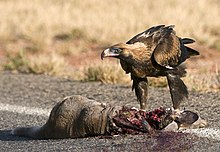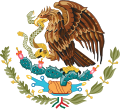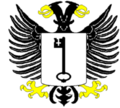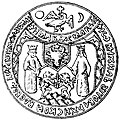Eagle: Difference between revisions
Reverted 1 edit by Flicka2494; Not an update. (TW) |
|||
| Line 29: | Line 29: | ||
| doi = 10.1126/science.176.4037.920 |
| doi = 10.1126/science.176.4037.920 |
||
| url = http://www./920?ck=nck |
| url = http://www./920?ck=nck |
||
| accessdate = 2007-11- |
| accessdate = 2007-11-20slob |
||
| pmid = 5033635 |
| pmid = 5033635 |
||
}}</ref> This keen eyesight is primarily contributed by their extremely large pupils which ensure minimal [[diffraction]] (scattering) of the incoming light. |
}}</ref> This keen eyesight is primarily contributed by their extremely large pupils which ensure minimal [[diffraction]] (scattering) of the incoming light. |
||
Revision as of 19:01, 30 April 2010
| Eagle | |
|---|---|

| |
| Bald Eagle | |
| Scientific classification | |
| Kingdom: | |
| Phylum: | |
| Class: | |
| Order: | Falconiformes (or Accipitriformes, q.v.)
|
| Family: | |
| Genera | |
|
Several, see text | |
Eagles are large birds of prey which are members of the bird family Accipitridae, and belong to several genera which are not necessarily closely related to each other. Most of the more than 60 species occur in Eurasia and Africa.[1] Outside this area, just two species (the Bald and Golden Eagles) can be found in the USA and Canada, nine more in Central and South America, and three in Australia.
Description
Eagles are differentiated from many other birds of prey mainly by their larger size, more powerful build, and heavier head and beak. Even the smallest eagles, like the Booted Eagle (which is comparable in size to a Common Buzzard or Red-tailed Hawk), have relatively longer and more evenly broad wings, and more direct, faster flight. Most eagles are larger than any other raptors apart from the vultures. Species named as eagles can range in size from the South Nicobar Serpent-eagle, at 500 grams (1.1 pounds) and 40 cm (16 in), to the 6.7-kg Steller's Sea Eagle and the 100 cm (39 in) Philippine Eagle.
Like all birds of prey, eagles have very large powerful hooked beaks for tearing flesh from their prey, strong muscular legs, and powerful talons. They also have extremely keen eyesight which enables them to spot potential prey from a very long distance.[2] This keen eyesight is primarily contributed by their extremely large pupils which ensure minimal diffraction (scattering) of the incoming light.
Eagles build their nests, called eyries, in tall trees or on high cliffs. Many species lay two eggs, but the older, larger chick frequently kills its younger sibling once it has hatched. The dominant chick tends to be the female, as they are bigger than the male. The parents take no action to stop the killing.
Species



Major new research into eagle taxonomy suggests that the important genera Aquila and Hieraaetus are not composed of nearest relatives, and it is likely that a reclassification of these genera will soon take place, with some species being moved to Lophaetus or Ictinaetus.[3]
- Bonelli's Eagle, the Booted Eagle and the Little Eagle have been moved from Hieraaetus to Aquila.
- Either the Greater Spotted Eagle and Lesser Spotted Eagle should move from Aquila to join the Long-crested Eagle in Lophaetus, or, perhaps better, all three of these species should move to Ictinaetus with the Black Eagle.
- The Steppe Eagle and Tawny Eagle, once thought to be conspecific, are not even each other's nearest relatives.
FAMILY ACCIPITRIDAE
- Subfamily Buteoninae - hawks (buzzards), true eagles and sea-eagles
- Genus Geranoaetus
- Black-chested Buzzard-eagle, Geranoaetus melanoleucus
- Genus Harpyhaliaetus
- Crowned Solitary Eagle, Harpyhaliaetus coronatus
- Solitary Eagle, H. solitarius
- Genus Morphnus
- Crested Eagle, Morphnus guianensis
- Genus Harpia
- Harpy Eagle, Harpia harpyja
- Genus Pithecophaga
- Philippine Eagle, Pithecophaga jefferyi
- Genus Harpyopsis
- New Guinea Eagle, Harpyopsis novaeguineae
- Genus Oroaetus
- Black-and-chestnut Eagle, Oroaetus isidori
- Genus Spizaetus
- Cassin's Hawk-eagle, Spizaetus africanus
- Changeable Hawk-eagle, S. cirrhatus
- Mountain Hawk-eagle, S. nipalensis
- Blyth's Hawk-eagle, S. alboniger
- Javan Hawk-eagle, S. bartelsi
- Sulawesi Hawk-eagle, S. lanceolatus
- Philippine Hawk-eagle, S. philippensis
- Wallace's Hawk-eagle, S. nanus
- Black Hawk-eagle, S. tyrannus
- Ornate Hawk-eagle, S. ornatus
- Black-and-white Hawk-eagle, S. melanoleucus
- Genus Lophaetus
- Long-crested Eagle, Lophaetus occipitalis - possibly belongs in Ictinaetus
- Genus Stephanoaetus
- Crowned Hawk-eagle, Stephanoaetus coronatus
- Genus Polemaetus
- Martial Eagle, Polemaetus bellicosus
- Genus Hieraaetus
- Ayres' Hawk-eagle, Hieraaetus ayresii
- African Hawk Eagle, H. spilogaster
- New Guinea Hawk-eagle, H. weiskei
- Genus Harpagornis (extinct)
- Haast's Eagle, †Harpagornis moorei - possibly belongs in either Hieraaetus or Aquila[4]
- Genus Geranoaetus

- Genus Aquila
- Bonelli's Eagle, Aquila fasciata - formerly Hieraaetus fasciatus
- Booted Eagle, A. pennata - formerly Hieraaetus pennatus
- Little Eagle, A. morphnoides
- Golden Eagle, A. chrysaetos
- Eastern Imperial Eagle, A. heliaca
- Rufous-bellied Eagle, A. kienerii
- Spanish Imperial Eagle A. adalberti
- Steppe Eagle, A. nipalensis
- Tawny Eagle, A. rapax
- Greater Spotted Eagle, A. clanga - to be moved to Lophaetus or Ictinaetus
- Lesser Spotted Eagle, A. pomarina - to be moved to Lophaetus or Ictinaetus
- Indian Spotted Eagle, A. hastata - to be moved to Lophaetus or Ictinaetus
- Verreaux's Eagle, A. verreauxii
- Gurney's Eagle, A. gurneyi
- Wahlberg's Eagle, A. wahlbergi
- Wedge-tailed Eagle, A. audax
- Genus Ictinaetus
- Black Eagle, Ictinaetus malayensis
- Genus Haliaeetus
- White-tailed Eagle, Haliaeetus albicilla
- Bald Eagle, H. leucocephalus
- Steller's Sea-eagle, H. pelagicus
- African Fish-eagle, H. vocifer
- White-bellied Sea-eagle, H. leucogaster
- Sanford's Fish-eagle, H. sanfordi
- Madagascar Fish-eagle, H. vociferoides
- Pallas' Sea-eagle, H. leucoryphus
- Genus Ichthyophaga
- Lesser Fish-eagle, Ichthyophaga humilis
- Grey-headed Fish-eagle, I. ichthyaetus
- Genus Aquila

- Subfamily Circaetinae: snake-eagles
- Genus Terathopius
- Bateleur, Terathopius ecaudatus
- Genus Circaetus
- Short-toed Eagle, Circaetus gallicus
- Black-chested Snake-eagle, C. pectoralis
- Brown Snake-eagle, C. cinereus
- Fasciated Snake-eagle, C. fasciolatus
- Banded Snake-eagle, C. cinerascens
- Genus Spilornis
- Crested Serpent-eagle, Spilornis cheela
- Nicobar Serpent-eagle, S. minimus
- Mountain Serpent-eagle,S. kinabaluensis
- Sulawesi Serpent-eagle, S. rufipectus
- Philippine Serpent-eagle, S. holospilus
- Andaman Serpent-eagle, S. elgini
- Genus Eutriorchis
- Madagascar Serpent-eagle, Eutriorchis astur
- Genus Terathopius
Eagles in culture
The word
The modern English name of the bird is derived from the Latin term aquila by way of the French aigle. The Latin aquila may derive from the word aquilus, meaning dark-colored, swarthy, or blackish, as a description of the eagle's plumage; or from aquilo, the Latin version of Greek boreas, or north wind; however, aquilus and aquilo may just as well derive from aquila (or be unrelated) and the latter be of unknown origin.
Old English used the term earn, related to Scandinavia's ørn / örn. The etymology of this word relates it to Greek ornís, meaning "bird", though other Indo-European languages (such as Welsh eryr or Russian orël / орёл) show that the meaning 'eagle' is older. The Greek word may be an old diminutive. The Albanian word for eagle is "shqiponje" deriving from the root "shq" which is the same for the word "shquaj" ("distinguish") and could be explained with the outstanding ability of the bird to distinguish clearly objects from long distances.
In Britain before 1678, Eagle referred specifically to the Golden Eagle, the other native species, the White-tailed Eagle, being known as the Erne. The modern name "Golden Eagle" for Aquila chrysaetos was introduced by the naturalist John Ray.
Eagles as national symbols
-
Coat of arms of the Albanian Kingdom (1928 - 1939)
-
Double-headed eagle emblem of the Byzantine Empire. Relief from the Ecumenical Patriarchate of Constantinople
-
Coat of arms of Egypt.
-
The Reichsadler symbol of the Holy Roman Empire of German Nation and Imperial Germany (1871-1918).
-
Coat of arms of Germany. It dates back to the eagle as a symbol of the Holy Roman Empire of German Nation (800-1806), the so called Bundesadler.
-
Coat of arms of Mexico. It dates back to the legend of the founding of the main Aztec city-state Tenochtitlan in 1325.
-
Napoleonic eagle.
-
Coat of arms of the town of Berg en Terblijt in the Netherlands, an example of the prolific use of the eagle in European heraldry.
-
Coat of arms of Federal Republic Of Nigeria.
-
Coat of arms of Poland. The symbol of an eagle appeared for the first time on the coins made during the reign of Bolesław I (992-1025), initially as the coat of arms of the Piast dynasty.
-
Coat of arms of the Romanian Principalities in 1600, having the Wallachian eagle on top.
-
Coat of arms of Russia.
-
Coat of arms of the Seljukians
-
Coat of arms of Serbia.
-
The Great Seal of the United States.
-
Coat of arms of Velletri.
-
Coat of arms of Armenia.
-
Coat of arms of Artsakh Republic.
Eagles have been used by many nations as a national symbol.
- The coat of arms of the Seljukian Empire has a double-headed eagle
- The coat of arms of Albania has a black double-headed eagle. Furthermore the eagle gives Albania its name ( in Albanian Shqiperia meaning Land of the eagles) and Albanians call themselves shqipetar or shqipe meaning eagles.
- The coat of arms of Armenia has a gold eagle and lion.
- The coat of arms of Austria has a black eagle.
- The coat of arms of the Czech Republic integrates the symbols of Moravia and Silesia (both with female eagles in their emblems - red-and-white chequered and black respectively) on the coat of arms of the Czech Republic with Bohemia's lion.
- The coat of arms of Egypt is a golden eagle looking towards the viewer's left. It is taking from the golden Eagle of Saladin founded on Saladin Citadel of Cairo .
- The coat of arms of Germany has a black eagle.
- The coat of arms of Ghana has two golden eagles holding it.
- The coat of arms of Iceland has a eagle holding it, as well as a dragon, a bull and a giant.
- The coat of arms of Indonesia has an eagle-like garuda carrying a shield on its neck and a banner on its feet.
- The coat of arms of Iraq has the golden Eagle of Saladin
- The coat of arms of Jordan has a black eagle.
- The coat of arms of Mexico has a golden eagle perched upon a cactus devouring a snake.
- The coat of arms of Moldova consists of a stylized eagle holding a cross in its beak and a sceptre and a branch in its claws.
- The coat of arms of Montenegro represents the two-headed eagle in flight.
- The coat of arms of Navarre/Basque Country Kingdom has a black eagle.
- The coat of arms of Nigeria has a red eagle on top.
- The Insignia of the Pakistan Air Force includes the Peregrine Falcon State Military national bird.
- The coat of arms of Panama has a harpy eagle
- The coat of arms of the Philippines has the bald eagle of the United States as a symbol of its colonial past, but the Monkey-eating Eagle is the de jure National Bird of the country.
- The coat of arms of Poland has a white eagle with a golden beak and talons wearing a golden crown.
- The coat of arms of Romania has a golden aquila holding a cross in its beak and a mace and a sword in its claws.
- The coat of arms of Russia has a gold double-headed eagle.
- The coat of arms of Serbia has a white bicephalic eagle of the House of Nemanjić.
- The coat of arms of Syria formerly had the eagle of Saladin.
- The Great Seal of the United States has a bald eagle.
- The coat of arms of Yemen depicts a golden eagle with a scroll between its claws.
- The coat of arms of Zambia has a orange red eagle on top.
- The coat of arms of Ghana has two eagles.
Historic uses:
- The Ptolemaic rulers of Egypt used it as their seal.
- Napoleon Bonaparte used the Roman Golden Eagle as the symbol of his new French empire.
- Persian Empire: the symbol of Persian Army was an Eagle
- The Romans used it on the standards of their armies. From this derives:
- The late Byzantine Empire chose a two-headed golden eagle as its symbol. It is popularly that one head symbolised ancient Rome, and the other head symbolised "new Rome" at Constantinople. From this derives:
- The two-headed eagle is the emblem of "Shqipëria" or Land of the Eagles, which is known in English as Albania (see The Tale of the Eagle for the legendary origin of the name)
- After the fall of Constantinople, the Russian Empire took the two-headed eagle as its own symbol.
- After his crowning as the new Roman Emperor, Charlemagne adopted the ancient Roman eagle as his own symbol. The Holy Roman Empire born of his kingdom took the eagle, but the Habsburgs replaced the golden eagle by an imperial eagle. From this derives:
- The Austrian Empire had a two-headed eagle as its symbol. After the abolition of Austria-Hungary, Austria took as its symbol a one-headed eagle in the modern coat of arms of Austria.
- Prussia, and later Germany have used a black eagle as their national symbol.
- The Spanish Catholic monarchs, Isabella and Ferdinand, used the eagle as a part of the royal shield representing Saint John the Evangelist. The eagle was again on the Spanish shield under the Francoist regime and the transition to Democracy (1939–1981).
- The late Byzantine Empire chose a two-headed golden eagle as its symbol. It is popularly that one head symbolised ancient Rome, and the other head symbolised "new Rome" at Constantinople. From this derives:
- The Seljuk Turks and Ottoman Turks used a double-headed eagle as coats-of-arms.
Religion
The eagle is the symbol used to depict John the Evangelist in some Christian churches. In art, John is sometimes depicted with an eagle.
The eagle is a sacred bird in some cultures and the feathers of the eagle are central to many religious and spiritual customs, especially amongst Native Americans in the United States and First Nations in Canada, as well as among many of the peoples of Meso-America. Some Native American peoples revere eagles as sacred religious objects and the feathers and parts of Bald and Golden Eagles are often compared to the Bible and crucifix. Eagle feathers are often used in various ceremonies and are used to honor noteworthy achievements and qualities such as exceptional leadership and bravery. In the cultures of the Northwest Coast, Eagle is also a supernatural being and also the ancestor and features in the heraldic crests of important clans known as totem poles.
The Moche people of ancient Peru worshipped the animal and often depicted eagles in their art.[5]
Despite modern and historic Native American practices of giving eagle feathers to non-indigenous people and also members of other tribes who have been deemed worthy, current United States eagle feather law stipulates that only individuals of certifiable Native American ancestry enrolled in a federally recognized tribe are legally authorized to obtain eagle feathers for religious or spiritual reasons.[6] In Canada, poaching of eagle feathers for the booming U.S. market has sometimes resulted in the arrests of First Nations person for the crime.[7]
In Hindu religion, Garuda is a lesser Hindu divinity, usually the mount (vahanam) of Vishnu. Garuda is depicted as having the golden body of a strong man with a white face, red wings, and an eagle's beak and with a crown on his head. This ancient deity was said to be massive, large enough to block out the sun.
Garuda's stature in Hindu religion can be gauged by the fact that an independent Upanishad, the Garudopanidad, and a Purana, the Garuda Purana, is devoted to him. Various names have been attributed to Garuda - Chirada, Gaganeshvara, Kamayusha, Kashyapi, Khageshvara, Nagantaka, Sitanana, Sudhahara, Suparna, Tarkshya, Vainateya, Vishnuratha and others. The Vedas provide the earliest reference of Garuda, though by the name of Śyena, where this mighty bird is said to have brought nectar to earth from heaven. The Puranas, which came into existence much later, mention Garuda as doing the same thing, which indicates that Śyena (Sanskrit for Eagle) and Garuda are the same. One of the faces of Śrī Pañcamukha Hanuman is Mahavira Garuda. This face points towards the west. Worship of Garuda is believed to remove the effects of poisons from one's body. In Tamil Vaishnavism Garuda and Hanuman are known as "Periya Thiruvadi" and "Siriya Thiruvadi" respectively.
In the Bhagavad-Gita (Ch.10, Verse 30), in the middle of the battlefield "Kurukshetra", Krishna explaining his omnipresence, says - "Of birds, I am the son of Vinata (Garuda)" indicating the importance of Garuda.
Garuda plays an important role in Krishna Avatar in which Krishna and Satyabhama ride on Garuda to kill Narakasura. On another occasion, Lord Hari rides on Garuda to save the devotee Elephant Gajendra. It is also said that Garuda's wings when flying will chant the Vedas.
The eagle is also the patron animal of Zeus
In popular culture
Songs about eagles include:
- Eimai aitos horis ftera (I am a wingless eagle, Greek: Είμαι αϊτός χωρίς φτερά) by Manos Hatzidakis and Eftichia Papagianopoulou, originally sung by Lakis Pappas
- Eimai o aitos (I am the eagle, Greek: Είμαι ο αϊτός) by Mimis Plessas and Dimitris Christodoulou, originally sung by Antonis Kalogiannis
- Enan aito zografisa (I painted an eagle, Greek: Έναν αϊτό ζωγράφισα) by Nikos Mamagakis and Dinos Dimopoulos, originally sung by Giannis Poulopoulos
- Enas aitos (An eagle, Greek: Ένας αϊτός), traditional
- Enas aitos gremistike (An eagle feel down, Greek: Ένας αϊτός γκρεμίστηκε) by Antonis Repanis and Eftichia Papagianopoulou, originally sung by Stratos Dionysiou
- Enas etoras aitos (An eagle-love, Greek: Ένας έρωτας αϊτός) by Minos Matsas and Akos Daskalopoulos, sung by George Dalaras
- Fly Like an Eagle by Steve Miller from the album Fly Like an Eagle
- O mavros aitos (The black eagle, Greek: Ο μαύρος αϊτός) by Giorgos Petsilas and Nikos Gatsos, originally sung by Nana Mouskouri
- Pare me aite (Take me eagle, Greek: Πάρε με αϊτέ) by Vangelis Germanos
- On Eagles' Wings is a sacred song by Michael Joncas
Nicknames
- The English football team Crystal Palace F.C. have an eagle on their badge and have the nickname "The Eagles"
References
- ^ del Hoyo, J.; Elliot, A. & Sargatal, J. (editors). (1994). Handbook of the Birds of the World Volume 2: New World Vultures to Guineafowl. Lynx Edicions. ISBN 8487334156
- ^ Shlaer, Robert (1972-05-26). "An Eagle's Eye: Quality of the Retinal Image". Science. 176 (4037): 920–922. doi:10.1126/science.176.4037.920. PMID 5033635. Retrieved 2007-11-20slob.
{{cite journal}}: Check|url=value (help); Check date values in:|accessdate=(help) - ^ Lerner, H. R. L. (2005). "Phylogeny of eagles, Old World vultures, and other Accipitridae based on nuclear and mitochondrial DNA". Molecular Phylogenetics and Evolution. 37 (37): 327–346. doi:10.1016/j.ympev.2005.04.010.
{{cite journal}}: Unknown parameter|coauthors=ignored (|author=suggested) (help) - ^ Bunce, M. (2005). "Ancient DNA Provides New Insights into the Evolutionary History of New Zealand's Extinct Giant Eagle". PLoS Biol. 3 (1): e9. doi:10.1371/journal.pbio.0030009. PMC 539324. PMID 15660162. Retrieved 2006-12-27.
{{cite journal}}: Unknown parameter|coauthors=ignored (|author=suggested) (help)CS1 maint: unflagged free DOI (link) - ^ Berrin, Katherine & Larco Museum. The Spirit of Ancient Peru:Treasures from the Museo Arqueológico Rafael Larco Herrera. New York: Thames and Hudson, 1997.
- ^ Office of Law Enforcement. "National Eagle Repository". Mountain-Prairie Region. United States Fish and Wildlife Service. Retrieved 2007-11-20.
- ^ Sin, Lena (2006-04-30). "Charges laid in eagle-poaching case". The Province. CanWest MediaWorks Publications Inc. Retrieved 2007-11-20.
Further reading
- Bruguier, Leonard.A Warrior's Eagle Feather
- Collinson, Martin. Splitting headaches? Recent taxonomic changes affecting the British and Western Palaearctic lists British Birds vol 99 (June 2006), 306–323
External links
- Eagle photos on Oriental Bird Images
- PBS Nature: Eagles
- Eagle videos on the Internet Bird Collection
- Eagle photos - including chick in nest
- Web of the Conservation Biology Team-Bonelli's Eagle, of the University of Barcelona
- Eagle Conservation Alliance (ECA)
- Eagle Stamps from around the world
- Accipitridae
- Eagles
- Heraldic birds
- National symbols of Afghanistan
- National symbols of Armenia
- National symbols of Austria
- National symbols of the Czech Republic
- National symbols of Germany
- National symbols of Ghana
- National symbols of Iraq
- National symbols of Liechtenstein
- National symbols of Mexico
- National symbols of Nigeria
- National symbols of Poland
- National symbols of Romania
- National symbols of Spain
- National symbols of Syria
- National symbols of Yemen
- National symbols of Zambia




















